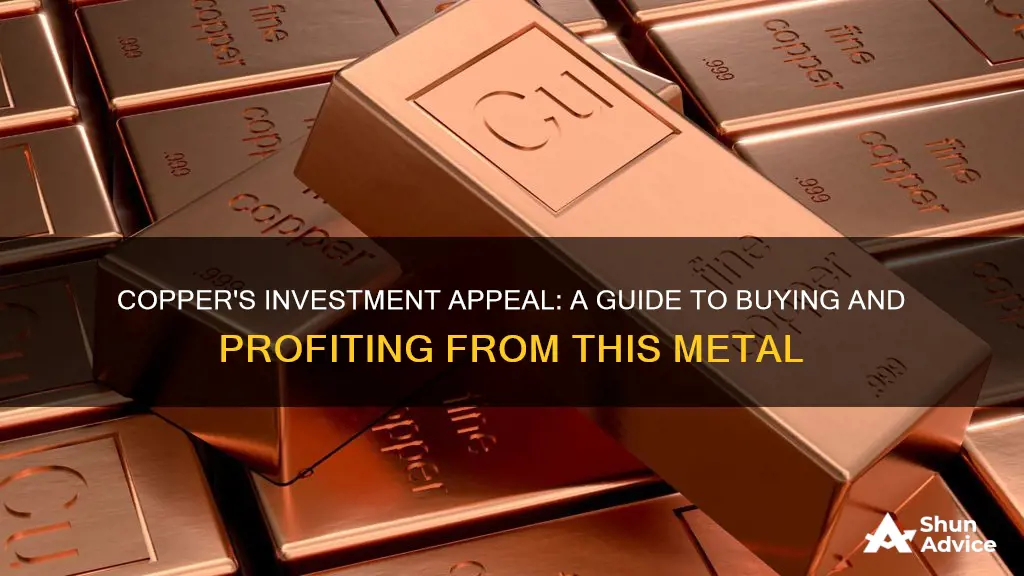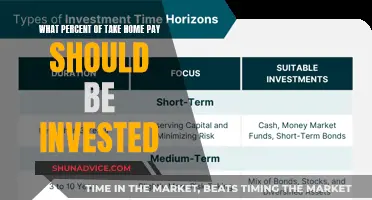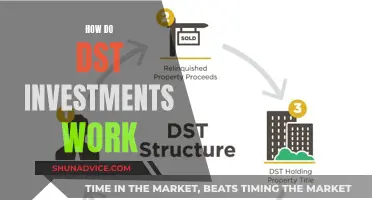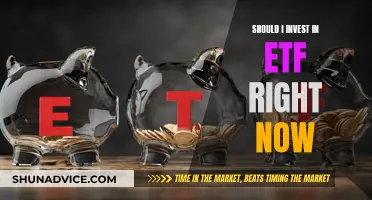
Copper is a versatile metal with a wide range of applications, from electrical wiring and plumbing to construction, electronics, and automobiles. It is in high demand due to its excellent thermal and electrical conductivity, resistance to corrosion, and malleability. As an investor, you can gain exposure to copper in several ways, each with its own risks and benefits. Here are some of the most common options:
- Copper Bullion: You can invest in physical copper bullion, such as bars, coins, or rounds. However, storage and transportation can be challenging due to the weight and volume of copper.
- Copper Mining Stocks: Investing in copper mining companies is a popular option, as it allows investors to benefit from both the increase in copper prices and the growth of the mining company. Examples include Freeport-McMoRan, BHP Group, and Rio Tinto.
- Copper ETFs: Copper Exchange-Traded Funds (ETFs) provide exposure to copper prices without the need to buy and store physical copper, offering more flexibility and diversification to your investment portfolio.
- Copper Futures and Options: You can invest in copper futures contracts, which allow you to buy or sell copper at a specified price on a future date. Options on futures contracts provide more flexibility, as you can choose not to fulfil the contract with limited losses.
| Characteristics | Values |
|---|---|
| Why invest in copper? | Copper is a highly versatile metal with a wide range of applications, from electrical wiring to plumbing to construction. It is also used in electric vehicles and renewable energy sources. |
| How to invest in copper? | Copper futures, copper ETFs, copper mining stocks, physical copper, buying shares in mining companies, exchange-traded funds (ETFs), futures and mining stocks. |
| Risks of investing in copper | Commodity price risk, currency risk, geopolitical instability, fluctuating commodity prices, operational risks, environmental impact, labour issues, corporate governance concerns. |

Copper bullion
Copper is a versatile metal with a wide range of applications, from electrical wiring to plumbing to construction. It is also traded in US dollars, so fluctuations in exchange rates can affect the value of copper investments.
When buying copper bullion, it is important to find reputable dealers and compare prices. Online dealers such as APMEX, JM Bullion, Silver Gold Bull US, and Hero Bullion offer a wide range of copper bullion products, including bars, coins, and rounds. Local dealers or pawn shops may also have copper bullion for sale.
It is important to note that the price of copper bullion is often directly associated with the current price of copper. Smaller-sized art bars and rounds are usually collected more for their artistic value, while larger-sized bullion bars tend to be more closely associated with the current copper price.
Investing in copper bullion has some drawbacks. One of the main concerns is the need to safeguard and store your physical copper. The low price-to-weight ratio of copper means that you would need to store a large quantity to accumulate significant value. Additionally, there is a risk of losing value on the purchase and sale of the metal due to brokers buying and selling at different prices.
The Role of a Financial Investment and Retirement Planner: Navigating Your Financial Future
You may want to see also

Copper mining stocks
Copper is a highly versatile metal with a wide range of applications, from electrical wiring to plumbing to construction. It is also used in electric vehicles and renewable energy technologies. As a result, copper has become a popular investment choice for those looking to diversify their portfolios.
Overview of Copper Mining Stocks
Due Diligence on Copper Mining Companies
When considering investing in copper mining stocks, it is crucial to conduct thorough research on the companies you are interested in. This includes analysing their financial performance, management team, and industry trends. Look at the company's history and future plans, as well as the global economic outlook for copper. Pay attention to environmental and corporate governance issues, as copper mining can be environmentally and socially controversial.
Diversification and Risk Management
To manage risk, it is advisable to diversify your investments across multiple copper mining companies and other types of copper investments, such as copper ETFs or physical copper. Diversification can help reduce the impact of any single company's underperformance or industry-wide downturns. Remember that investing in individual stocks, especially mining stocks, carries inherent risks, so it is important to understand the business well before investing.
Examples of Copper Mining Stocks
- Freeport-McMoRan Inc (FCX): A well-known and respected company in the industry, with operations in North and South America, as well as Indonesia.
- BHP Group Ltd (BHP): A diversified mining company with copper mining operations in Chile, Peru, and the United States, among other locations around the globe.
- Rio Tinto Group (RIO): A global copper and mineral mining company based in London, with operations in open pit and underground mines, refineries, smelters, processing plants, and shipping operations.
- Southern Copper Corporation (SCCO): An $82 billion copper company with strong cash flows and profitability, and exploration, mining, and mineral operations across multiple countries.
- Glencore PLC (GLNCY): A $72 billion minerals company that operates in various regions worldwide, producing and selling copper and a range of other industrial metals.
- Metals Acquisition Ltd (MTAL): A copper mining company with a focus on environmentally conscious practices and a core holding in the CSA Copper Mine in Australia, known for producing high-grade copper ore.
A Smart Strategy: Investing $400,000 for Retirement
You may want to see also

Copper ETFs
- United States Copper Index Fund (CPER): This ETF is designed to reflect the performance of copper futures on the COMEX exchange. It has an expense ratio of 1.04%, and while it may be a good pick for capturing short-term moves in copper's price, the nature of rolling futures contracts can cause asset value erosion over time.
- Global X Copper Miners ETF (COPX): With an expense ratio of 0.65%, investing in companies worldwide engaged in copper mining and exploration. Its top holdings include pure-play copper miners such as Southern Copper and Freeport-McMoRan Inc.
- Sprott Junior Copper Miners ETF (COPJ): Managed by Sprott Asset Management, COPJ tracks the performance of the Nasdaq Sprott Junior Copper Miners Index, focusing on mid-, small-, and micro-cap companies in the copper mining, development, and exploration sectors. It has an expense ratio of 0.75% and includes Compania de Minas Buenaventura and Ero Copper among its top holdings.
- IShares Copper and Metals Mining ETF (ICOP): This ETF, managed by BlackRock, has an expense ratio of 0.47%. It tracks the investment results of an index composed of US and non-US equities of companies primarily engaged in copper and metal ore mining. Top holdings include Grupo Mexico S.A.B. de C.V. and Freeport-McMoRan.
- IShares Global Select Metals & Mining Fund (PICK): Also managed by BlackRock, PICK offers more diverse exposure to the non-precious metals and mining space. It tracks the investment results of an index composed of global equities of companies primarily engaged in the mining, extraction, or production of diversified metals, excluding gold and silver. Its top holdings include BHP Billiton and Rio Tinto.
Retirement Planning: Navigating the Investment Maze
You may want to see also

Copper futures
Futures can be used to hedge against risk in the copper industry, but there is substantial risk in the futures market when investing. Copper futures can be a way to make (or lose) money quickly on the moves of an already volatile commodity. If the price moves in your favour, you could turn a small sum into a large one fast. However, if the price moves against you, you will need to deposit money with the broker (called margin) to keep the position. Otherwise, the broker will close the position and you will suffer a loss.
If you want to invest in copper futures, you will need a broker that allows futures trading, and not all major brokers provide this service.
The Great Debate: Mortgage Freedom or Investment Opportunities?
You may want to see also

Copper futures ETFs
One example of a copper futures ETF is the United States Copper Index Fund (CPER), which has an expense ratio of 1.04%. The fund aims to reflect the performance of copper futures on the COMEX exchange and primarily holds copper futures contracts.
Another option for investing in copper futures is through exchange-traded notes (ETNs), such as the iPath Series B Bloomberg Copper Subindex Total Return ETN. ETNs are similar to ETFs but provide access to the returns of a market benchmark. The iPath ETN has a lower investor fee of 0.45% and has more closely matched the return of the copper index it tracks. However, like copper futures ETFs, ETNs are generally better suited for short-term trades rather than long-term investments due to the costs of rolling contracts forward.
Value Investing: A Rare Gem
You may want to see also
Frequently asked questions
Like any investment, there are risks associated with investing in copper. Copper prices are volatile and can be influenced by many factors, including global supply and demand, geopolitical events, and economic conditions. Copper is traded in US dollars, so investors outside of the US are exposed to currency risk. Fluctuations in exchange rates can affect the value of copper investments.
There are several ways to invest in copper, including buying physical copper bullion, investing in copper mining stocks or ETFs, or trading copper futures and options.
Copper is a highly versatile metal with a wide range of industrial applications, making it an attractive investment opportunity. The demand for copper is expected to remain high due to its use in electric vehicles, renewable energy infrastructure, and construction. However, investing in copper carries risks, including price volatility and the environmental and social impact of copper mining.
Copper investing may be suitable for investors looking to diversify their portfolio and gain exposure to a metal that plays a pivotal role in the transition to clean energy and net-zero emissions. However, it is important to consider the risks associated with investing in copper, including price volatility and the impact of macroeconomic factors on the metal's supply and demand.







